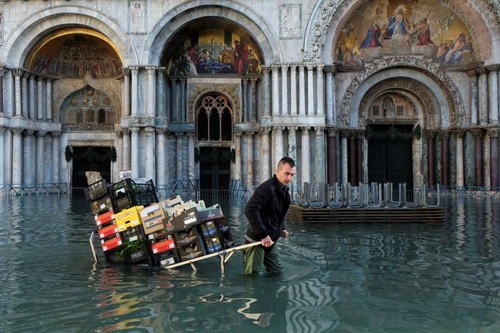© Turkuvaz Haberleşme ve Yayıncılık 2024
The year 2019 has taken us one step closer to an impending climate apocalypse and marked a crux in the lives of future generations.
Over the last couple of decades, nations the world over have begun to roll up their sleeves to deal with global climate change and ensure the safety of our grandchildren and the planet for generations to come.
Despite promises to halt emissions, greenhouse gases and other elements behind the rise in global temperatures have increased unabated so that by the beginning of 2019 the planet is now the hottest it has been in some 120,000 years. The last 19 years alone have been the warmest on record and concentrations of greenhouse gas are the highest they have been in millions of years.

A man pulls a cart carrying fruits and vegetables through a flooded St. Mark's Square in Venice, Italy Dec. 24, 2019. (Reuters Photo)
What is the world to do?
The United Nations continued to spearhead the efforts to encourage collective action on global climate change. On Sept. 23, the U.N. Climate Action Summit that took place at the headquarters of the United Nations in New York made headlines as the biggest climate summit of the year. Officially declared the "Climate Action Summit 2019: A Race We Can Win. A Race We Must Win," the conference, unfortunately, amounted to little in the way of progress on the issue, with China remaining firm on its commitments to the Paris Agreement, India refusing to pledge to reduce its use of coal and the U.S. declining to even speak at the summit.
The U.N. Climate Change Conference COP 25 that gathered in Madrid, Spain, between Dec. 2 and 13 under the presidency of Chile, similarly amounted to little. The participant countries neither committed to any guarantees nor agreed on any resolutions over carbon markets in order to ensure the safety of future generations.
On the other hand, these governments' paralysis has spawned a new wave of climate change warriors, mostly formed from the leagues of the younger generation who are set to feel the phenomenon's worst consequences.
Greta and the young activists
For years, scientists and experts have been warning us that our world is turning on us for having disturbed its natural order. Although climate activists have long called on governments for urgent action, most chose to turn a blind eye, until now.
Everything began when a 16-year-old Swedish high school student named Greta Thunberg started skipping school to protest in front of parliament in Stockholm in the summer of 2018. With this gesture, Greta – since named the Person of the Year by TIME Magazine – has urged the younger generation to step up to protect their future, sparking a new wave of climate activists. Greta's example inspired millions of young people around the world, who in turn, decided to take to the streets. Becoming a climate icon, Greta's Friday for Future movement as led to strikes in 3,804 locations across 161 countries. The biggest of these was seen on March 15, taking place in over 100 countries across the world with the involvement of some 1.6 million students.
Extinction Rebellion has been another climate movement that has rallied millions behind the fight for a better future. The movement wants governments to declare a "climate and ecological state-of-emergency" and take immediate action to address climate change. The group describes itself as an international "non-violent civil disobedience activist movement." In April 2019, supporters of Extinction Rebellion held a large demonstration in London over the course of two weeks. Some of the city's busiest thoroughfares were "occupied" by the activists, whose movement has since spread to Amsterdam, Sydney and various global capitals.
